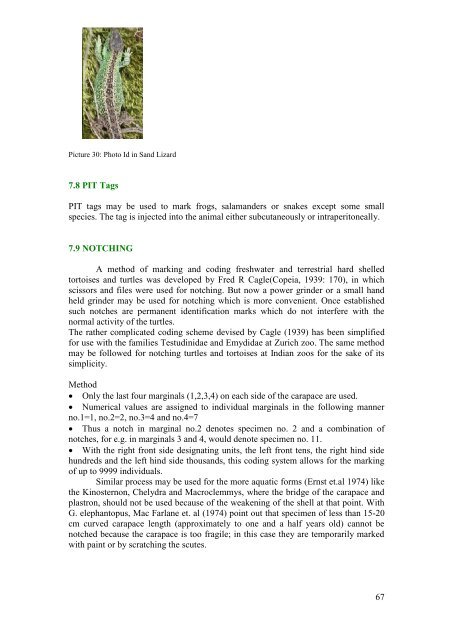standardization of records keeping in indian zoos - Central Zoo ...
standardization of records keeping in indian zoos - Central Zoo ...
standardization of records keeping in indian zoos - Central Zoo ...
Create successful ePaper yourself
Turn your PDF publications into a flip-book with our unique Google optimized e-Paper software.
Picture 30: Photo Id <strong>in</strong> Sand Lizard<br />
7.8 PIT Tags<br />
PIT tags may be used to mark frogs, salamanders or snakes except some small<br />
species. The tag is <strong>in</strong>jected <strong>in</strong>to the animal either subcutaneously or <strong>in</strong>traperitoneally.<br />
7.9 NOTCHING<br />
A method <strong>of</strong> mark<strong>in</strong>g and cod<strong>in</strong>g freshwater and terrestrial hard shelled<br />
tortoises and turtles was developed by Fred R Cagle(Copeia, 1939: 170), <strong>in</strong> which<br />
scissors and files were used for notch<strong>in</strong>g. But now a power gr<strong>in</strong>der or a small hand<br />
held gr<strong>in</strong>der may be used for notch<strong>in</strong>g which is more convenient. Once established<br />
such notches are permanent identification marks which do not <strong>in</strong>terfere with the<br />
normal activity <strong>of</strong> the turtles.<br />
The rather complicated cod<strong>in</strong>g scheme devised by Cagle (1939) has been simplified<br />
for use with the families Testud<strong>in</strong>idae and Emydidae at Zurich zoo. The same method<br />
may be followed for notch<strong>in</strong>g turtles and tortoises at Indian <strong>zoos</strong> for the sake <strong>of</strong> its<br />
simplicity.<br />
Method<br />
Only the last four marg<strong>in</strong>als (1,2,3,4) on each side <strong>of</strong> the carapace are used.<br />
Numerical values are assigned to <strong>in</strong>dividual marg<strong>in</strong>als <strong>in</strong> the follow<strong>in</strong>g manner<br />
no.1=1, no.2=2, no.3=4 and no.4=7<br />
Thus a notch <strong>in</strong> marg<strong>in</strong>al no.2 denotes specimen no. 2 and a comb<strong>in</strong>ation <strong>of</strong><br />
notches, for e.g. <strong>in</strong> marg<strong>in</strong>als 3 and 4, would denote specimen no. 11.<br />
With the right front side designat<strong>in</strong>g units, the left front tens, the right h<strong>in</strong>d side<br />
hundreds and the left h<strong>in</strong>d side thousands, this cod<strong>in</strong>g system allows for the mark<strong>in</strong>g<br />
<strong>of</strong> up to 9999 <strong>in</strong>dividuals.<br />
Similar process may be used for the more aquatic forms (Ernst et.al 1974) like<br />
the K<strong>in</strong>osternon, Chelydra and Macroclemmys, where the bridge <strong>of</strong> the carapace and<br />
plastron, should not be used because <strong>of</strong> the weaken<strong>in</strong>g <strong>of</strong> the shell at that po<strong>in</strong>t. With<br />
G. elephantopus, Mac Farlane et. al (1974) po<strong>in</strong>t out that specimen <strong>of</strong> less than 15-20<br />
cm curved carapace length (approximately to one and a half years old) cannot be<br />
notched because the carapace is too fragile; <strong>in</strong> this case they are temporarily marked<br />
with pa<strong>in</strong>t or by scratch<strong>in</strong>g the scutes.<br />
67
















